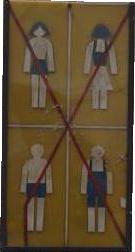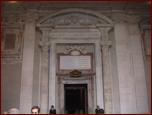
Roma Cast of Characters Campo dé Fiori Caffè San Pietro Colosseo Foro Romano Chiesa del Gesu Pantheon P. Navona S. Pietro Il Papa S. Eustachio S. Maria Trastevere Trastevere Bocca Verità Fontana di Trevi Museo Vaticani Villa Borghese Vittorie Mangia! Loose Ends Desktops
|
.
.
.
.
.
.
.
.
.
.
.
.
.
.
.
.
.
.
.
.
.
.
.
.
.
.
.
.
.
.
.
.
.
.
.
.
.
.
.
.
.
.
|
2000 Italia: Basilica di San Pietro (Saint Peter's Basilica) 2
 The dress code is clearly marked: no short pants and no bare shoulders. Bare midriffs are unwelcome too. Tank tops, skimpy athletic tops, displays of skin, and clingy clothes are problematic. It's hard to tell when and where in Rome this dress code will be enforced, but it's a good bet that you'll be challenged in St. Peter's, the Vatican Museums, and some of the other churches. Of course, by the time you see this sign you're far away from your hotel, so pack your day pack accordingly.
Those of you who know me know that I spend much of my life in shorts. Even in cold weather, even in the overcast rain, I travel with hiking boots and white-water sandals, shorts, and a GoreTex jacket. Luckily for our group I keep a very lightweight pair of pants tightly wrapped in the bottom compartment of the "big boy backpack", under Isaac's seat. In the full view of several of the Swiss Guard and a couple bemused tourists I unroll and don my pants without taking off the pack or my boots. Then we enter walk under the façade, between the columns, to come face-to-face with the Puerto Santo (the Holy Door; Portam Sanctam in Latin). We're able to walk through the Puerto Santo because we're in a Jubilee Year.
The dress code is clearly marked: no short pants and no bare shoulders. Bare midriffs are unwelcome too. Tank tops, skimpy athletic tops, displays of skin, and clingy clothes are problematic. It's hard to tell when and where in Rome this dress code will be enforced, but it's a good bet that you'll be challenged in St. Peter's, the Vatican Museums, and some of the other churches. Of course, by the time you see this sign you're far away from your hotel, so pack your day pack accordingly.
Those of you who know me know that I spend much of my life in shorts. Even in cold weather, even in the overcast rain, I travel with hiking boots and white-water sandals, shorts, and a GoreTex jacket. Luckily for our group I keep a very lightweight pair of pants tightly wrapped in the bottom compartment of the "big boy backpack", under Isaac's seat. In the full view of several of the Swiss Guard and a couple bemused tourists I unroll and don my pants without taking off the pack or my boots. Then we enter walk under the façade, between the columns, to come face-to-face with the Puerto Santo (the Holy Door; Portam Sanctam in Latin). We're able to walk through the Puerto Santo because we're in a Jubilee Year.
 Year of Jubilee, also called Holy Year, in the Roman Catholic church, a celebration that is observed on certain special occasions and for 1 year every 25 years, under certain conditions, when a special indulgence is granted to members of the faith by the pope and confessors are given special faculties, including the lifting of censures. It resembles the Old Testament Jubilee--in which, every 50 years, the Hebrews celebrated a year of perfect rest, emancipated slaves, and restored hereditary property--but does not seem to be based on it.
Pope Boniface VIII established the Holy Year in 1300 as a centenary observance. In 1342 Clement VI reduced the interval to 50 years, and in 1470 Paul II further reduced it to 25 years. The year begins on Christmas Eve, with the opening of the Holy Doors at the Roman basilicas of St. Peter, St. John Lateran, St. Paul Outside-the-Walls, and St. Mary Major, and ends with their closing on the following Christmas Eve. Since 1500 the Jubilee has been extended to the whole world during the year following the Holy Year, and certain churches in each diocese are designated for visitation. (From the Encyclopædia Britannica; used without permission.)
Year of Jubilee, also called Holy Year, in the Roman Catholic church, a celebration that is observed on certain special occasions and for 1 year every 25 years, under certain conditions, when a special indulgence is granted to members of the faith by the pope and confessors are given special faculties, including the lifting of censures. It resembles the Old Testament Jubilee--in which, every 50 years, the Hebrews celebrated a year of perfect rest, emancipated slaves, and restored hereditary property--but does not seem to be based on it.
Pope Boniface VIII established the Holy Year in 1300 as a centenary observance. In 1342 Clement VI reduced the interval to 50 years, and in 1470 Paul II further reduced it to 25 years. The year begins on Christmas Eve, with the opening of the Holy Doors at the Roman basilicas of St. Peter, St. John Lateran, St. Paul Outside-the-Walls, and St. Mary Major, and ends with their closing on the following Christmas Eve. Since 1500 the Jubilee has been extended to the whole world during the year following the Holy Year, and certain churches in each diocese are designated for visitation. (From the Encyclopædia Britannica; used without permission.)
We enter the biggest church I've ever seen.
|
 subscribe
subscribe
 subscribe
subscribe
